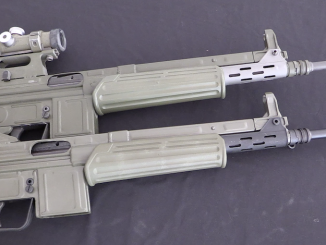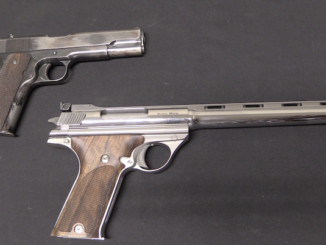Colt held a dominant market share in revolver sales in the 1880s, but was quite interested in taking a piece of the rifle market as well. This initially manifested with the Colt Burgess lever-action rifle, which prompted the famous alleged agreement between Colt and Winchester that Colt would not make lever action rifles and Winchester would not make revolvers. Well, if that agreement really did happen, Colt took a pretty technical view of it – because in 1884 – the year after pulling the Burgess rifle from the market – they introduced a new rifle.
This was the Colt Lightning, a slide-action design patented by William Elliot and purchased by Colt in 1883. The first model was the medium frame, offered in .32-20, .38-40, and .44-40 – companion cartridges to match Colt’s revolvers. This was followed by two more models in 1888; a large “Express” version to compete with the Winchester 1876 and 1886 and a small .22 rimfire version.
The Express would be the worst-selling by far, with just 6,498 produced despite being offered in 5 different calibers (.38-56, .40-60, .45-60, .45-85, and .50-95). It was dropped in 1894. The medium frame did much better, with 89,777 made by the time it ceased in 1902. The small frame rimfire Lightning was the most popular, with 89,912 made by 1904, when all production ceased.
Sold for $2,300 (medium frame), and $3,450 (large frame) at the December 2019 RIA Premier auction (small frame did not sell).




If you want to read more about the Colt/Winchester feud I suggest pages 124-129 of ‘The Winchester Repeating Arms Company’ by Herbert G. Houze. Pretty interesting stuff. Winchester went to full scale war. They hired Colt’s chief engineer, William Mason, publically announced plans to build pump action rifles and revolvers, and dumped large numbers of their English made shotguns onto the market at reduced prices, to depress the sales of Colt’s side by side shotgun.
Maybe someday Ian could do a segment on this piece of American gun history.
Slide-action rim-fire rifles are still popular today, unless I’m totally off. At least they work well for target shooting and, more practically, pest control with suppressed barrels. Cops and exterminators prefer to not scare the neighborhood just for the ballistic elimination of huge rats… giant bamboo rats from Southeast Asia not withstanding, a .22 LR weapon will do. No need to aggravate Holmes and Watson.
A friend had one of the 22 rimfire versions, when he loaded it with .22 short it seemed that he would put 1/2 a box of ammo in and never need to reload.
-Hudson
“(…)Slide-action rim-fire rifles are still popular today,(…)”
This would explain why Uberti choose to make replica of mid-size variant:
https://www.ubertireplicas.com/product/1884-lightning-rifle-carbine/
thus targeting less saturated section of market (slide-action rifles firing hand-gun sized cartridges).
According to advertising material of Colt Nothing was faster than lightning
https://www.guns.com/news/2014/01/09/colt-lightning-pump-action-rifles-lightning-bottle
I am not sure if that holds true when compared to lever-action of that era, but it seems to be appealing marketing slogan. Did Winchester responded to it in any way?
Italian companies are doing excellent job with vintage American arms replicas. Maybe they were inspired by Spaghetti westerns 🙂
Lets check, http://www.imfdb.org/wiki/Colt_Lightning_Carbine lists only one movie – For a Few Dollars More. One is not much, but my understanding this one was quite influential.
I did not intent my comment specifically related to this arm, but mostly in general sense. Back in old country we had Italian made Western pants (blue jeans) with prominent name on patch RIFLE. People for most part ignorant of proper English pronunciation, called them Rif-leh 🙂
“(…)Slide-action rim-fire rifles are still popular today, unless I’m totally off.(…)”
Not only today. Do not overlook fact, that one of firsts fire-arms designed by John M. Browning (known as designer of M2 .50 machine gun) put into production belong to this category – namely Winchester Model 1890: https://en.wikipedia.org/wiki/Winchester_Model_1890
It was also important step in cartridge development, as .22 Winchester Rimfire was introduced together with it, which would later spawn .22 Winchester Magnum Rimfire cartridge.
Reputedly they prone to jam – was / is this true and was it inherent or just one of the types ?
My experience with slide-action rifles has been limited to .22 RFs, and that says they at least do tend to jam. Or rather, they have poor primary extraction, and thus tend to be troublesome with high-pressure .22 LRs like the CCI Stinger etc.
Bolt-action .22 RFs with tubular magazines seem to be the most reliable repeating arms in that class, with lever-action tubular magazine ones a close second. Both have stronger primary extraction than any other repeating .22 RF rifle action, including self-loaders.
The worst combination is a self-loader with a box magazine. Even Col. Cooper, a strong advocate of self-loaders for any and all occasions, noted that few .22 RF self-loaders with box magazines, including pistols, were inherently reliable feeders. The problem with box magazines is simply that they are not well adapted to feeding rimmed cartridges, and the .22 LR has an enormous rim in proportion to the rest of the cartridge. In a larger version, it would be roughly like having a .45-70 with the rim of a 12-gauge shotgun shell.
Probably the best option for a .22 LR repeating rifle, if you demand as near absolute reliability in repeat fire as possible, is a very 19th Century choice; either a bolt-action or a lever-action, with a tubular magazine. Best of all would probably be one with the magazine in the buttstock, as opposed to under the barrel, but to my knowledge the only .22 rifles with that arrangement are self-loaders like the Browning and the Remington Nylon 66.
I note that the Remington Nylon 77, with its slightly-curved box magazine, should be avoided at all costs. I used to own one, and one was one too many.
It’s interesting to think that the best .22 repeating rifle that was never made might have been a Winchester-Hotchkiss, or a Spencer.
cheers
eon
“(…)The problem with box magazines is simply that they are not well adapted to feeding rimmed cartridges, and the .22 LR has an enormous rim in proportion to the rest of the cartridge. In a larger version, it would be roughly like having a .45-70 with the rim of a 12-gauge shotgun shell.(…)”
And how does rotary magazine, like one used in Ruger Model 77/22 repeating rifle, fares reliability-wise when used together with .22 rim-fire cartridge?
“(…)It’s interesting to think that the best .22 repeating rifle that was never made might have been a Winchester-Hotchkiss, or a Spencer.(…)”
Wait. But did not putting magazine in this direction (to “aft”) restrict its length and thus capacity, when opposite direction (to “bow”) with utilizing full length of barrel giving higher capacity, unless exceptionally short barrel is used?
Many years ago I saw a photo of Winchester’s revolver that they reportedly showed Colt and asked the Colt representative what he thought of it? I just love the snarky way that Winchester told Colt that Colt could not get away with going into rifle production.
I don’t remember what Winchester’s revolver looked like now, but I remember at the time that their revolver looked like it could have been successful.
Maybe Eon could dig one of those up from somewhere?
“(…)what Winchester’s revolver looked like(…)”
See 1st photo from top here:
https://peashooter85.tumblr.com/post/140717230965/the-winchester-wetmore-wells-single-action
Daweo beat me to the 1873 Winchester-Wetmore, but there was also the later Winchester-Borchardt revolver;
https://images.proxibid.com/AuctionImages/3693/165626/17.jpg
And the Winchester-Mason of 1883;
https://revivaler.com/winchester-1883-prototype-revolver/
It’s still debated which of these two was shown to Colt’s CEO in 1883. Elmer Keith stated that the “gentleman’s agreement” did in fact exist, and that it was the reason that the Colt-Burgess and Whitney-Scharf lever-action rifles were not pursued very strongly by Colt.
The Colt Lightning seems to have been a side issue. In the beginning, Colt mainly pursued foreign sales that Winchester didn’t. In Australia, the Colt Lightning rifle was sold as the Colt “Daisy” kangaroo rifle, generally in .32-20 WCF. Yes, ‘roos were hunted for their skins and as a serious threat to agriculture; think of very fast and fecund deer with nearly-bottomless appetites.
In South America, the Colt Lightning in .44-40 was marketed as a military rifle, complete with bayonet. Again, this was a market Winchester didn’t care much about.
In the end, the foreign rifle markets mainly went to the company that very much did care about them and had a superior product. That is, DWM and their Mauser bolt-action.
cheers
eon
Here you are:
J. S. (Stan) Robinson: Did You Know that Winchester Made a Revolver? [http://corregidor.org/acgq/web_redirect_3628.3645.8883/forum_pages/student%20of%20arms/robinson_0804.html]
Jon C. Branch: Winchester 1883 Prototype Revolver [https://revivaler.com/winchester-1883-prototype-revolver/]
Lot 1024: The Winchester ‘Centennial 1876’ Single Action Revolver [https://www.rockislandauction.com/detail/68/1024/the-winchester-centennial-1876-single-action-revolver]
The Winchester 1876 Centennial Revolver And The Gentlemen’s Agreement [https://www.youtube.com/watch?v=nfFSYj8cWgI]
Lot 1052: Winchester Prototype Revolver 45 LC [https://www.rockislandauction.com/detail/60/1052/winchester-prototype-revolver-45-lc]
5 Rare and Unusual Firearms Seen in September 2019 Rock Island Premiere Firearms Auction Catalog [https://www.thefirearmblog.com/blog/2019/08/27/5-rare-and-unusual-firearms-seen-in-september-2019-rock-island-premiere-firearms-auction-catalog/]
I had never heard of it marketed as a military rifle – any details as to sales etc. ?
It was mentioned in an article in the book Guns of the World published by Petersen in 1972 (rep. Bonanza Press 1978), and illustrated on P. 220 of the latter edition. The caption reads;
Keep in mind those are 1972 prices. At the time, a “run of the mill” Winchester M1886 in .45-70 sold for around $250 to $450. A recent sale of one at RIA had a reserve of $27K. I would say that, as a general rule, if you take the 1972 prices quoted in GOTW and tack two more zeros on to the left of the decimal point, you should be somewhere in the ball park for present-day (2019) auction prices for most items.
However, a rare Colt Lightning type, of which only about 200 were made to begin with, would probably go significantly higher.
cheers
eon
I have one of these rifles that I would like to sell but I don’t know much about it. I know it’s not I’m working order and I think it’s the 32 caliber one. I haven’t looked at it in a while. Any idea of value? The finish is pretty rough I don’t think anything is cracked or rusted away though.